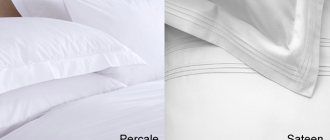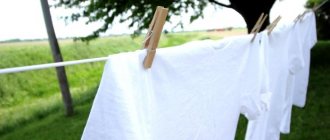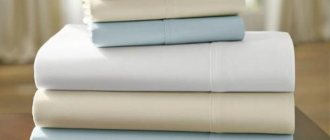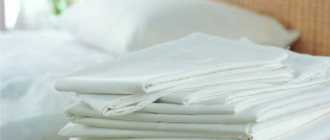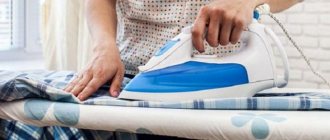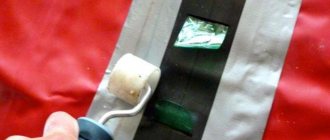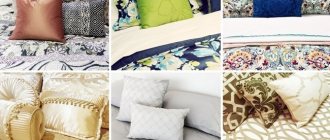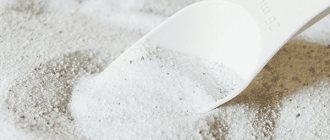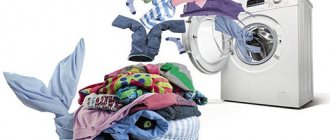Sleep is an important component of human life. Whether it will be strong and calm depends on many factors, and good bedding plays an important role in this matter. It's not just about beauty, which creates a good mood and sets you up for sweet dreams. Bed linen comes into contact with the human body, and strict requirements are placed on it. To choose the best, you need to consider for what purpose it is purchased.
Types of bed linen
The term “bed linen” combines textile sleep accessories: duvet covers, sheets, pillowcases. Products are made from various fabrics and different sizes. Depending on the cost and purpose, it is manufactured in three types:
- elite,
- budget,
- children's
Luxury lingerie
Luxury bed linen is the most expensive in this category of goods, but it is distinguished not only by the solid number on the price tag. It looks luxurious thanks to:
- carefully selected fabrics;
- noble shades of colors;
- sophisticated design;
- original decor.
Lace, hand and machine embroidery are used to decorate luxury lingerie. To create a luxurious set we use
- natural silk,
- best quality satin;
- cotton fabric made from long-fiber varieties of raw materials (pima, maco);
- cotton jacquard;
- linen.
Budget underwear
Inexpensive budget bedding sets for daily use, which are preferred by most buyers, are in high demand. They are made from calico, percale or poplin. There is no decorative trim on it. The main functional characteristics are practicality and wear resistance. Numerous washes will not spoil the brightness of its print.
Kids clothes
Bed linen intended for children has similar characteristics to budget linens. It must be practical and wear-resistant. A prerequisite is softness and hypoallergenicity. Children's bedding is made from
- calico,
- percale,
- Ranforsa,
- calico,
- satin,
- polycotton.
The last two are recommended for children aged seven years and older. Satin has a higher density and will be rough for little ones. Polycotton contains polyester, which is not suitable for newborns and children from three to seven years old.
Flannel
The fabric is divided into three types: cotton, wool and wool blend. It has double-sided and single-sided sparse pile, which gives the fabric softness and comfort.
Advantages: the fabric perfectly retains heat, absorbs moisture, retains color and shape after washing.
Disadvantages: takes a long time to dry, forms pellets with prolonged use.
What to look for when choosing bedding
Choosing bed linen requires a responsible attitude to several basic criteria.
Firstly, the manufacturer. It's good if it is known in the market. New brands are often not inferior in quality to the masters, but are cheaper. How to determine which of the little-known manufacturers you should trust.
Packaging can tell you a lot. Just as a person is greeted by his clothes, the first impression of a bedding set is created by its design. A self-respecting manufacturer will never skimp on packaging. She is the face of his product, and the more attractive it is, the greater the chance of success. In addition, the packaging must contain all the information about the product:
- the form of fabric,
- configurations,
- sizes.
Secondly, it is recommended to evaluate the linen visually and by touch. It is necessary to inspect the processing of seams. Seams in the sheets are also a big drawback. A pleasant feeling when touched will help you make a final decision.
Thirdly, it is recommended to do a test for the quality of dyes. To do this, just run a cotton pad over the surface of the product. The absence of traces will confirm the high quality of the linen.
Fourthly, before purchasing, you need to decide what is the priority requirement for linen: strength or softness. The answer to this question determines what fabric you should use to buy a bedding set.
You might be interested in learning how to choose a blanket based on filling
What raw materials
In order not to guess which material is better to choose bed linen from - natural or artificial, remember the axiom: in any good set, most of the composition should be made of natural fibers.
Natural ones include:
- Cotton;
- Linen;
- Silk;
- Wool.
The first two are made from plants, while silk and wool are made from animal materials.
Artificial fabrics are:
- Polyester;
- Lavsan;
- Bamboo;
- Tencel;
- Viscose.
Synthetic fabrics are usually not used in their pure form; they are mixed into natural compositions to give strength, shape, and color.
Which fabric is better
Bed linen for everyday use is made from
- calico,
- percale,
- poplin,
- satin.
It is impossible to say objectively which fabric is better. Each buyer has his own priorities according to which he makes a choice. It is necessary to analyze the characteristics of each fabric to determine the best option. The video demonstrates the main types of fabrics that are used in sewing bed linen and their features:
Percale or poplin
Percale or poplin which is better? Comparing percale and poplin is a thankless task. Both fabrics are popular with customers and even have the same characteristics. In both cases, natural cotton and traditional plain weaving technology are used in production, that is, the threads are simply intertwined with each other in a checkerboard pattern. This is where the similarities end.
Percale is much thinner, denser and stronger than poplin. This difference is explained by the threads used. In percale they are thinner and, when woven, form a dense and durable structure. In addition, percale threads are not twisted. They are pre-combed and coated with a special compound with adhesive properties. You can make sure that percale is denser than poplin visually. It is enough just to look through the fabric into the light.
Percale was originally used to make sails, aircraft covers and parachutes. Later they began to make bedding from it. The strength of the fabric made it possible to hold feathers inside pillows and feather beds.
Percale or satin
These two chic fabrics are both worth considering when choosing bedding. Each of them can be considered the best, depending on the preferences of the buyer.
Percale is a thin, cambric-like, but very durable fabric with a pleasant velvety surface. A special technology is used in its production. Untwisted threads are treated with an adhesive composition, which increases its resistance to wear.
Satin is suitable for those who prefer premium bedding. The fabric has an exquisite silky sheen. In its production, a twisted double weave thread is used. It is this that gives the fabric a noble shine.
Important! It should be borne in mind that satin for bed linen comes in different qualities. For budget products, regular fabric is used. Dense, but with a slight matte sheen. For luxury linen, you need high quality satin, not inferior in luxury to silk, but made from cotton.
Percale or satin, which is better? Having decided that pleasant velvety and noble shine are more important, it’s easy to choose the best fabric.
Percale or calico
What's better? Dealing with these two types of fabric is more difficult than it seems at first glance. They are very similar to each other in appearance and characteristics.
- They are made from natural cotton.
- They are well ventilated and absorb moisture.
- The fabrics are durable and wear-resistant.
- Products made from calico and percale do not wrinkle and are easy to care for.
- Woven with plain weave.
Percale bed linen is more expensive, but with the same characteristics, the question arises: why pay more.
Upon careful examination, it becomes noticeable that percale is thinner, lighter, smoother and softer to the touch. These characteristics are given to the fabric by untwisted threads, which become even thinner after being coated with an adhesive. The result is a denser and, accordingly, more durable weave.
Poplin or calico
What's better? What is the difference between poplin and calico? The fabrics have similar characteristics and are approximately the same price. Poplin is a little more expensive, since the fabrics used are mainly imported. Manufactured using plain weaving technology. Poplin uses threads of varying thicknesses. The result of this technique was a slightly rough surface of the fabric. Calico is more smooth. A perfectly flat surface contributes to less abrasion during operation, which significantly extends service life.
Poplin or satin
Fabrics with almost the same characteristics, but differ in texture. Poplin has a pleasant rough surface due to the use of threads of different thicknesses when weaving. A light transverse rib is easy to feel to the touch. Satin is made from crowded threads, which gives the fabric a silky shine.
Considering that when sewing satin bed linen, fabric of various qualities is used, premium sets are distinguished by their chic shine, bright pattern, and resistance to washing.
When choosing budget kits, it is recommended to be guided by personal preferences. When purchasing luxury lingerie, satin will be unrivaled.
Calico or satin
Cotton fabrics have a lot in common:
- density,
- temperature preservation,
- softness,
- wear resistance (but satin has higher resistance).
Supporters of calico bedding sets are attracted by the affordable price. Lovers of luxurious bedroom interiors highlight the noble shine of satin, making it look like silk or satin.
Advice! It should be borne in mind that satin can achieve shine artificially - by rolling the fabric between hot rollers. The fabric will fade with each wash.
Poplin deserves 2nd place
Poplin bed linen is loved by many, and this is no coincidence. It is incredibly pleasant and gentle. Falling asleep in his arms, you will feel comfort and relaxation. All the fatigue that has accumulated during the day will instantly go away, and you will plunge into a calm, serene sleep.
However, the name “poplin” does not indicate the composition of the fabric, but the method of weaving the fibers. Both natural and artificial fibers can be used as a base. However, more often the “natural” composition predominates.
Advantages:
- Soft and gentle to the touch;
- Easy care;
- Strength and durability;
- Practically does not wrinkle;
- Dries quickly;
- Suitable even for allergy sufferers;
- Safe material;
- Suitable for any time of year;
- Does not interfere with air circulation;
- Easy to paint;
- Acceptable price.
But it is worth noting one small drawback:
- May shrink when washed (up to 10%).
Comparing the advantages and disadvantages, we can say with confidence that poplin is a worthy fabric with excellent characteristics.
Material Density
One of the main criteria when choosing bed linen is its resistance to wear, which depends on the density of the fabric. The main thing is to maintain the softness of the sleeping accessories, ensuring a comfortable rest.
To choose reliable bedding that will last a long time, it is enough to study the density of the types of fabric used:
- for percale - from 100 to 160 g/m2;
- for calico - from 100 to 145 g/m2;
- for satin - from 120 to 140 / m2;
- poplin has 110 g/m2.
According to GOST, the maximum values are taken, so percale is the densest, and therefore wear-resistant. Calico is slightly inferior to it, but this fabric has a more affordable price.
Ranfors
An improved version of calico fabric. The increased number of fibers is one and a half times higher than the density of ranphos compared to calico, which significantly affects its service life. Additional cleaning of the fibers and their cross-shaped weaving give the fabric smoothness, softness and silkiness.
Advantages: does not fade or shrink even after numerous washes.
Disadvantages: costs more than calico.
Dimensions
Inconsistency in the size of bedding items leads to discomfort during sleep. If the bed linen is smaller than the size of the pillow, blanket or mattress, then folds and creases will form, causing a lot of inconvenience. If the size is too large, it is easy to get tangled in the duvet cover or get your hand caught in the pillowcase. To simplify the selection of bed linen, special standards have been developed that all products included in the set must meet.
There are several types of bed linen:
- single,
- one and a half,
- double,
- eurostandard,
- family,
- children's,
- for newborns.
For each type, there are standard sizes of pillowcases, sheets and duvet covers.
Mako satin
The production technology is reminiscent of the production of luxury satin fabric, and its composition includes only first-class cotton.
Advantages: the fabric is not prone to wrinkle, become electrified, or cause an allergic reaction. Environmentally friendly. Does not deform after washing, dries quickly. It looks simply luxurious on the bed.
Disadvantages: none found.
Bed linen size chart
| Types of linen | Pillowcase | Sheet | Duvet cover |
| Single | 50x70 | 110x200 | 135x200 |
| One and a half | 70x70 | 150x220 | 145x215 |
| Double | 70x70 | 180x220 | 175x215 |
| Eurostandard | 50x70 or 70x70 | 220x240 | 200x220 |
| Family | 70x70 | 220x240 | 145x215 (2 pcs.) |
| Children's | 40x60 | 100x140 | 100x140 |
| For newborns | 35x45 | 100x135 | 100x138 |
The video guide explains how to choose the right bed linen size.
Useful information about the sizes of children's mattresses. Rules for determining the size of a mattress for a cradle, for a child's and teenage bed. https://matrasium.ru/matrasy/kak-vybrat/razmery-detskih-matrasov/
Atlas
Silk and semi-silk fibers contained in the fabric give it a smooth, silky, luxurious and rich appearance.
Benefits: The fabric is durable, wear-resistant, breathable, temperature-controlled, wrinkle-resistant and incredibly soft.
Disadvantages: expensive, washable only on delicate cycle or by hand.
Quality of seams and threads
The service life of bed linen depends not only on the correct fabric. The quality of seams and threads plays an important role in this matter. Before purchasing, it is advisable to open the package and carefully inspect the seams.
Some should be double folded and stitched. A single seam or its absence indicates a violation of the requirements. After the first wash, such linen will become frayed and unusable.
The threads must be strong and match the color of the fabric. The absence of protruding ends is a prerequisite for quality bed linen.
Polycotton
A synthetic fabric created back in the 50s of the last century and containing cotton and polyester.
Advantages: the fabric has an affordable price, wear resistance, practicality, hygiene, ease of care, no need for ironing.
Disadvantages: poor air permeability, electrification, pellets after washing, can cause an allergic reaction to synthetic components.
The best bed linen manufacturers
Today, the domestic market offers underwear from Russian and foreign companies. Among the numerous offers, buyers highlight
- Monolit (Russia),
- Artpostel (Russia),
- Vasilisa (Russia),
- Saylid (Russia),
- On Silk (Russia),
- TAS (Türkiye),
- Asabella (China),
- Valterry (China),
- Cleo (China),
- Blakit (Belarus).
All products have earned positive reviews and are popular with customers.
Satin
Fabric made from natural cotton, made by double twisting of fibers. Popular among housewives due to its rich color range.
Advantages: smooth, silky, durable, perfectly breathable, does not wrinkle and does not cause allergic reactions.
Disadvantages: its price is higher than other cotton fabrics.
Average price for bed linen
Prices for bed linen depend on various factors: quality, material used, brand.
Prices for domestic products today range from 1050 to 1400 rubles. Belarusian offers successfully compete with Russian bed linen. Their cost on average is 1090 rubles.
Turkish-made kits cost about 1,700 rubles. Goods from China have a similar price (on average the price varies from 1,550 to 1,750 rubles). Elite bed linen Cleo is more expensive, on average about 3,000 rubles per set.
A price that is too low indicates low quality; a high price indicates numerous resellers in the “manufacturer-seller” chain.
Calico
Natural cotton fabric with plain weave.
Advantages: the fabric allows air to pass through freely, has excellent hygienic properties, is durable, wear-resistant, and easy to care for.
Disadvantages: it is not soft enough according to some consumers.
Tips for choosing good bedding
Choosing bed linen is a responsible step. It depends on the purpose of its acquisition.
If you buy a budget option for yourself, the right decision will determine how comfortable you will sleep in the near future. To ensure a successful purchase, it is recommended
- Choose a manufacturer carefully;
- Carefully inspect the packaging of the selected kit;
- Open it and inspect the offered product (primarily the seams);
- Check dye stability.
By following these recommendations, you can easily ensure a comfortable sleep.
If we are talking about purchasing a gift, you should opt for an elite set made of satin or silk.
Linen
One of the most natural fabrics presented in the rating.
Advantages: the fabric is environmentally friendly, temperature-controlled, gyroscopic and perfectly breathable. It has unique antiseptic properties and prevents the development of bacteria and microorganisms.
Disadvantages: it wrinkles easily, has a limited range of colors, and is more expensive than cotton fabrics.
Silk
One of the most beautiful, expensive and presentable fabrics. The most valuable is Japanese silk. It is a “breathable” material, retains body heat, does not cause allergies, is pleasant to the touch, and has a high ability to absorb and transport moisture. But the cost of original Japanese products often exceeds the price of the bed itself. True, there are cheaper Chinese or Turkish analogues, but their quality is not as high.
Natural silk requires a special approach. Caring for it is the most difficult. It is advisable to dry clean the silk set or wash it by hand. Chinese or Turkish sets can be machine washed. To do this, you need to set the “silk” or “wool” program, the temperature to 30°C and the spin speed to a maximum of 400 rpm. Dry outdoors, but away from the sun. Iron with damp steam or set the iron to “silk” mode.
Jacquard
The fabric is made using a special jacquard weaving. The weaving method allows you to add texture to the fabric and your own unique pattern. Jacquard linen will bring a touch of aristocracy to your bedroom.
Advantages: the fabric has a luxurious appearance, softness and silkiness.
Disadvantages: not everyone can afford it.
Satin stripe
High-quality all-natural cotton fabric from the elite category. It is produced using the technology of satin weave fibers, twisting them obliquely.
Advantages: practical, wear-resistant fabric with an impressive appearance.
Disadvantages: very expensive.
Percale
“Royal” fabric made in the best Irish traditions. Can be made from: linen, cotton, cotton base mixed with synthetic fiber. The special smoothness of the fabric is given by a unique manufacturing method - sizing, which literally glues the fibers together.
Advantages: the fabric is strong, durable, not prone to deformation, does not fade, has excellent air permeability, absorbs moisture, does not cause allergic reactions, and is moderately expensive.
Disadvantages: none found.
We hope our article will help you make your choice. Happy shopping and sweet dreams!
Smell
Good bedding should only smell like new textiles; additional odors (paint, mold or chemicals) indicate its low quality. If the kit has too strong a paint smell, it means it will most likely shed quickly. In addition, such underwear can cause allergies and even poisoning.
Pay attention to the color intensity: it should not differ much from the back and front sides.
We check the durability of paint application as follows: rub it firmly on the front side with your hand, if there are no colored marks, then the paint is durable and the linen is of good quality. You can also find out how good a dye is from the values on the label: if the maximum permissible washing temperature is 60 ° C, then it is stable.
Knitwear
Knitwear is a knitted fabric with a loop structure, due to which the fabric becomes elastic and stretches well. Knitwear absorbs moisture well, provides natural ventilation of linen, and has hypoallergenic qualities. Made from 100 percent cotton. Cotton jersey does not pill and maintains a smooth texture throughout use.
Knitwear does not require particularly complex care. It does not shrink during washing and drying, dries quickly, and does not wrinkle much. Washing is allowed at temperatures up to 60°C. You can choose any type of drying: machine or open air.

